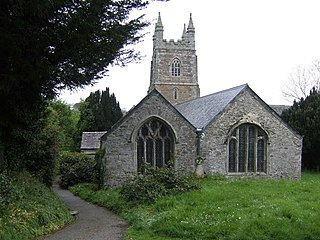
Creed is a village and former civil parish, now in the parish of Grampound with Creed, in the Cornwall district, in mid Cornwall, England. It is roughly midway between Truro and St Austell, about two miles (3 km) east of Probus. In 1961 the parish had a population of 203. On 1 April 1983 the parish was abolished to form "Grampound with Creed", part also went to St. Mewan.

St Bartholomew's Church is a parish church of the Church of England Diocese of Truro in Lostwithiel, Cornwall, England, United Kingdom.

Probus is a civil parish and village in Cornwall, England, in the United Kingdom. It has the tallest church tower in Cornwall. The tower is 129 feet (39 m) high, and richly decorated with carvings. The place name originates from the church's dedication to Saint Probus. The parish population at the 2011 census was 2,299, whereas the ward population taken at the same census was 3,953.
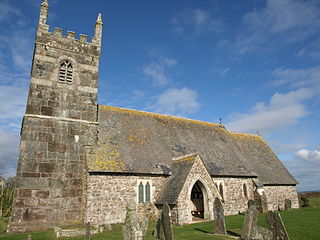
St Grada & Holy Cross Church, Grade is the Church of England parish church of Grade with Ruan, Cornwall. The church is a Grade I listed building, having been added to the listed buildings register on 10 July 1957.

St Uny Church, Lelant, is the Church of England parish church of Lelant, Cornwall, England. It is dedicated to Saint Uny who is also the patron saint of Redruth. It is a Grade I listed building.

St Michael and All Angels Church, Penwerris is a parish church of the Church of England located in Penwerris, near Falmouth, Cornwall. The church is Anglo-Catholic and under the care of the Bishop of Oswestry rather than the diocesan bishop.

St Paul's Church, Truro is a Grade II listed former parish church in the Church of England Diocese of Truro and in Truro, Cornwall.

St Julitta's Church, St Juliot is a Grade II* listed parish church in the Church of England Diocese of Truro in St Juliot, Cornwall.
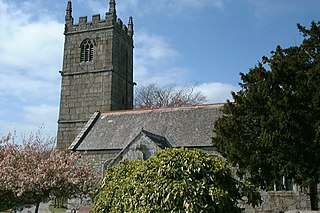
St Erth’s Church, St Erth, is a Grade I listed parish church in the Church of England Diocese of Truro in St Erth, Cornwall, England, UK.

St Gwinear's Church, Gwinear is a Grade I listed church in the Church of England in Gwinear, Cornwall.

St Gothian's Church, Gwithian is a Grade II* listed parish church in the Church of England Diocese of Truro in Gwithian, Cornwall, England, UK. Nothing is known about St Gothian, Gocianus or Gwithian.

St Ladoca's Church, Ladock, is a Grade I listed parish church in the Church of England Diocese of Truro in Ladock, Cornwall, England, UK.

St Crida's Church, Creed is a Grade I listed parish church in the Church of England Diocese of Truro in Creed, Cornwall, England, UK.
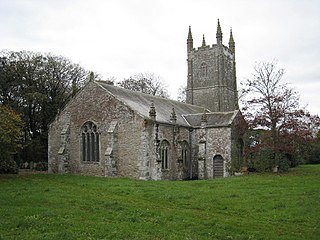
St Hermes’ Church, St Erme is a Grade II* listed parish church in the Church of England Diocese of Truro in St Erme, Cornwall, England, UK.
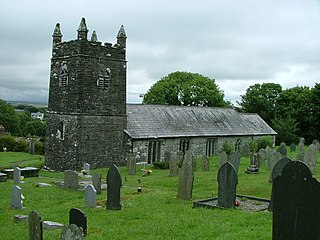
St Werburgh's Church, Warbstow is a Grade II* listed parish church in the Church of England in Warbstow, Cornwall.
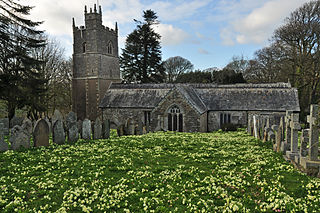
St Martin's Church is a parish church in the hamlet of St Martin, Looe, Cornwall, in the Church of England Diocese of Truro.

St Martin and St Meriadoc's Church, Camborne is a Grade I listed parish church in the Church of England in Camborne, Cornwall.

All Saints’ Church, Tuckingmill is a Grade II listed parish church in the Church of England in Pendarves Street, Tuckingmill, Camborne, Cornwall.

St Julitta's Church, Lanteglos-by-Camelford is a Grade I listed parish church in the Church of England Diocese of Truro in Lanteglos-by-Camelford, Cornwall.

St Columba's Church is a 14th-century, Grade I listed parish church in the Church of England Diocese of Truro in St Columb Major, Cornwall. In 1860 plans were drawn up by William Butterfield, in hope of St Columb church becoming the cathedral of the future diocese of Cornwall, but the cathedral was built at Truro. A second church dedicated to the same saint is known as St Columba's Church, St Columb Minor.





















